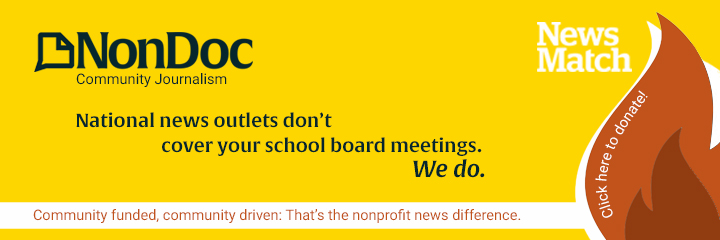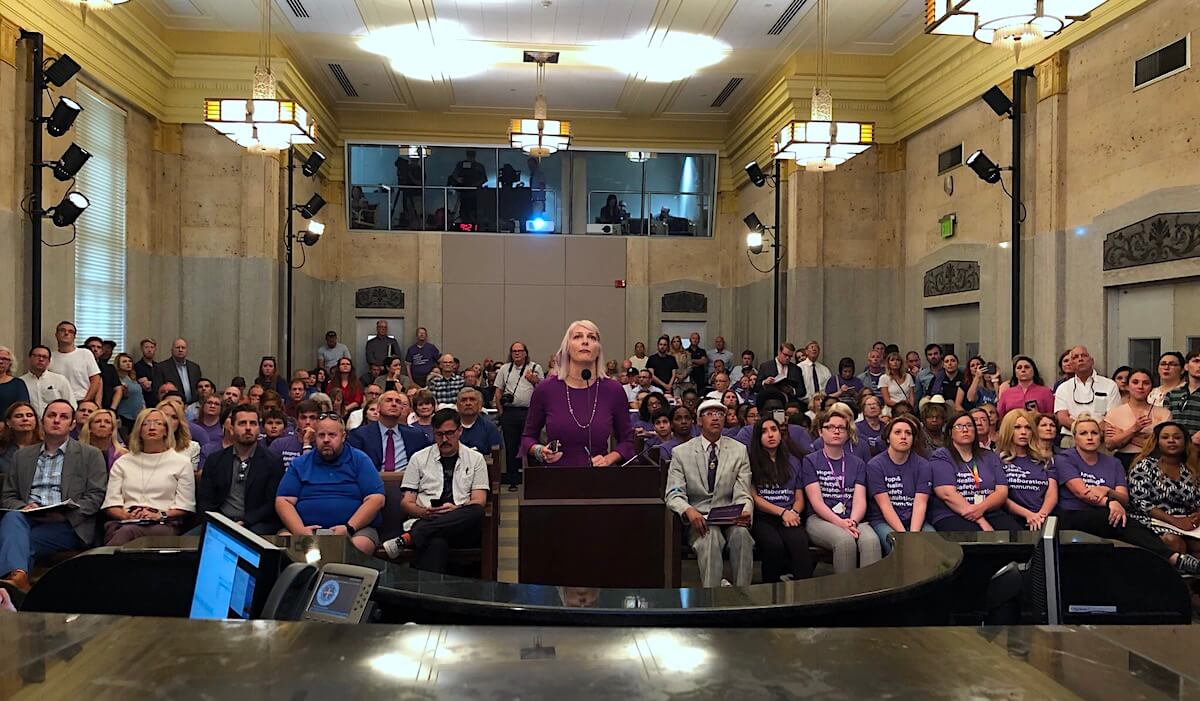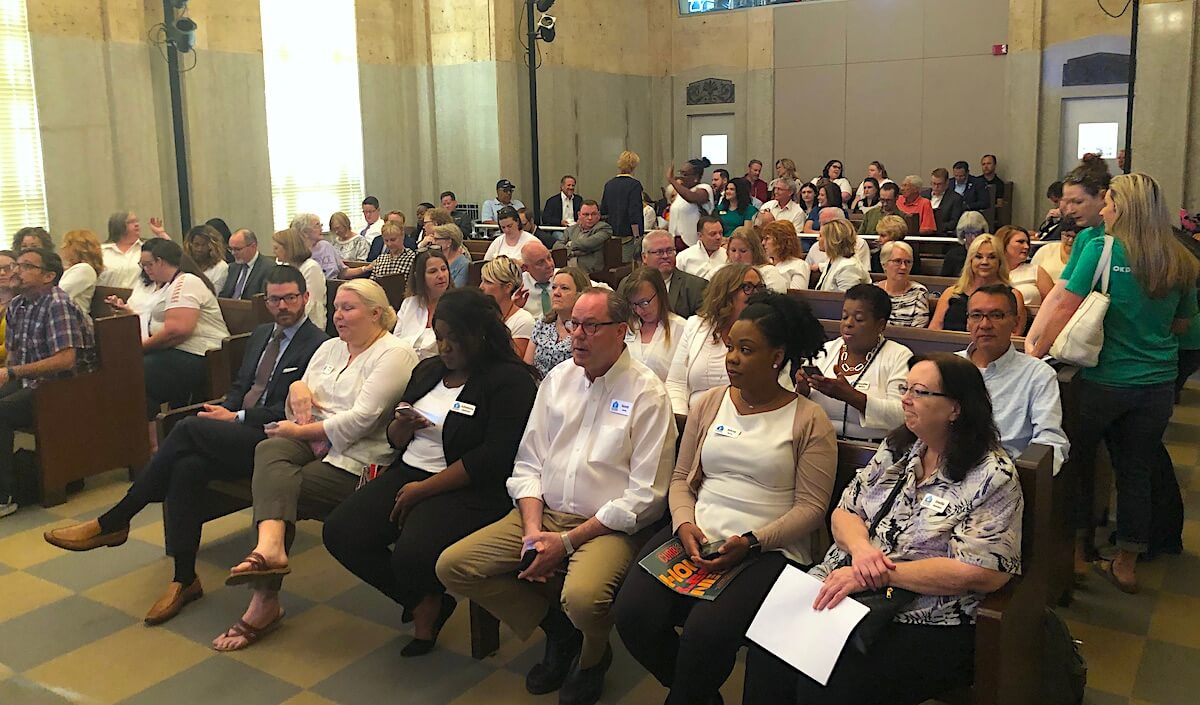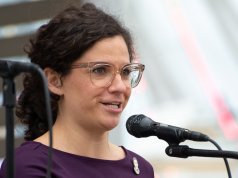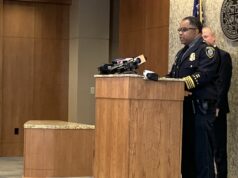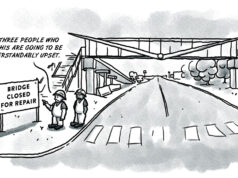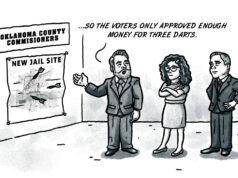

An outdoor stadium, expanded mental health care and a high-concept idea to boost innovation in Oklahoma City were all part of the final round of MAPS 4 presentations Tuesday.
The stadium presentation included two options. One design would cost between $37 to $42 million and would seat about 8,000 spectators.
The second option would cost between $67 to $72 million but would seat just two thousand more.
Either way, it’s something the city needs, at least according to Robert Funk, Jr., co-owner of Energy FC, which would call the stadium home if it were built.
“Oklahoma City is the 12th largest city in the country, yet we’re the only city among the country’s top 50 largest that doesn’t have a large, multipurpose, outdoor stadium,” Funk said.
It’s unclear where exactly such a stadium would be located or whether it might ultimately play home to a Major League Soccer franchise. MLS has expressed plans to expand, and Funk said he hopes a new stadium would be centrally located near public transportation and restaurants.
Funk attempted to purchase a 37-acre tract of land in downtown Oklahoma City in 2016 that served as the home of the now-demolished Producers Cooperative plant, but the sale fell through. It’s possible the stadium, if approved by voters, could be on that site.
Several other community members spoke about the stadium proposal as well.
Oklahoma City resident David Glover spoke out against the stadium proposal during the public comments section of the presentation. Glover said the stadium was unpopular, citing a recent Sooner Poll that found the majority of voters didn’t favor the construction of a stadium.
“The mayor said we would never put something on the maps ballot if it wasn’t polling 50 percent,” Glover said. “There’s been one scientific poll that asked about the soccer stadium. I would say be careful. I wouldn’t want there to be a golden goose that screws up MAPS.”
Tom Bakken, a member of VOICE, also spoke against the stadium.
“There are a number of other proposals that I think are more important than this one,” he said. “For one, soccer can be supported through a part of the parks proposal that sponsors the fixing of our existing soccer fields scattered throughout the city. Secondly, there are lots of other proposals that need to be done. You guys are faced with a tough choice. I know it’s economically good, but you have to think about who the public is and how they get served.”
Current facility called inadequate
Funk said Taft Stadium on North May Avenue is inadequate for long-term use by the team given parking issues and field size, which is not regulation. Funk said the Energy are the only professional soccer team in North America that plays in a high school venue.
RELATED
‘Dream big’: City hears first set of MAPS 4 proposals by Matt Patterson
“Taft was never meant to be a permanent home for us,” Funk said. “We have issues with parking, we don’t have the ability to produce concessions, the facility is really a blank slate. And the inflow and outflow is difficult from a traffic standpoint.”
Funk said the area also lacks restaurants and bars for fans to visit before and after games.
His proposed downtown stadium would also be used for concerts, lacrosse and for a variety of high school sporting events including football. OSSAA executive director David Jackson also spoke in favor of the proposal.
Mental health could receive attention
Tuesday’s presentations kicked off with how OKC’s mental health care needs could be addressed through MAPS 4.
Plans presented by Oklahoma County Commissioner Carrie Blumert called for $42 million in spending. That would include two additional crisis centers, a restoration center and expanded housing for those with mental health problems.
Oklahoma ranks 42nd nationally when it comes to access to mental health services, Blumert said. An estimated one in five Americans can be diagnosed with with a mental health condition in any given year.
“Our proposal is about every single person in our community who we have failed,” she said. “(We can help them) by providing the right treatment and the best care at the right time.”
More mental health beds would be provided
Blumert said the restoration center would provide for 16 mental health beds along with services like medical detox, a pharmacy and would house a mobile crisis outreach team.
RELATED
Arena, animals, kids take center stage at second MAPS 4 forum by Matt Patterson
The crisis intervention centers would provide assessment, detoxification, crisis de-escalation, respite, counseling and adequate sleep for those experiencing a mental health crisis.
The expanded housing would provide 30 units of transitional living for those being discharged from crisis centers.
Cost of operating the facilities would be about $19 million annually, the commissioner said.
Investment for innovation district?
The final item in the MAPS 4 presentations centered on an innovation district in northeast OKC which is among the most conceptual ideas presented during the summer meetings. And at $100 million, it’s also the second most expensive.
Under the proposal, $20 million would be spend on construction of an innovation hall. An additional $15 million would be used for the Henrietta B. Foster Center for Minority Small Business Development and Entrepreneurship.
A further $5 million would be set aside for renovation of Booker T. Washington Park, and $30 million would go toward connectivity and accessibility improvements.
Finally, the annual operated costs would be about $30 million, according to the presentation.
MAPS 4 plan expected to generate jobs
Overall, the MAPS 4 plan could generate more than 6,000 jobs and $423 million in income with a combined annual economic benefit of $1.1 billion, councilmembers were told Tuesday.
RELATED
Third MAPS 4 forum: $130 million proposed for Thunder arena by Matt Patterson
Moreover, Oklahoma City Chamber of Commerce President Roy Williams said a wave of technological advances are either here already arriving or on their way.
“Forces like globalization, autonomous vehicles, cloud technology genomics, energy storage, robots and 3-D printing, all of these will disrupt our industries and our communities,” Williams said.
Being ready is critical, he said.
“Oklahoma city must be forward-leaning to become a part of this disruption, not just react to what it does to us,” he said.
(Correction: This story was updated at 1 p.m. Friday, Aug. 9, to note that an attempted land sale fell through. NonDoc regrets the error.)
